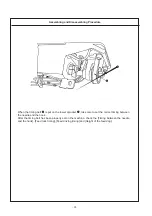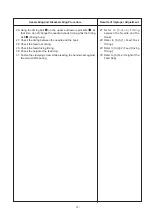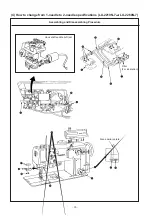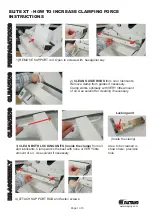
– 108 –
3-4) Defective hook components
4-A) Thread path of the hook has scratches.
Smoothen the thread path.
4-B) Blade point of the hook is blunt or worn out.
Correct the blade point of the hook or replace the
hook with a new one.
4-C) Clearance between the blade point of the
Widen the clearance to allow the thread to come
hook and the inner hook stopper is too small.
off the hook smoothly.
4-D) Hook timing is too early.
Adjust the hook timing.
4-E) The inner hook opening lever provides
Adjust the clearance.
an excessive clearance.
4-F) The needle interferes with the blade
Adjust the needle-to-hook relation.
point of the hook.
3-5) Thread take-up spring has been
5-A) Stroke of the thread take-up spring is
Re-adjust the stroke of the thread take-up spring.
improperly adjusted
too large or too small.
5-B) Tension of the thread take-up spring is
Re-adjust the spring tension.
too high or too low.
3-6) Sewing speed is too high.
6-A) The needle generates heat, resulting in
Decrease the sewing speed.
thread breakage.
Wind the thread around the needle.
3-7) The installing point of the needle is too low
7-A) Height of the needle bar is insufficient.
Raise the needle bar.
7-B) Needle is not attached in the needle bar
Attach the needle in the needle bar.
in the correct manner.
3-8) Pressure of the presser foot is too low.
8-A) Stitches gather on the overlapped section
Increase the pressure of the presser foot.
of a material, resulting in thread breakage.
3-9) Incorrect needle entry
9-A) Needle interferes with the needle hole
Re-adjust the needle entry point. (Refer to [3.-(3)]).
edge of the throat plate.
Trouble
Cause (1)
Cause (2)
Check Procedure and Corrective Measures
Continued from the previous page
















































